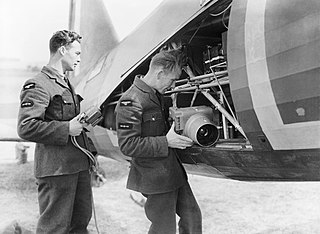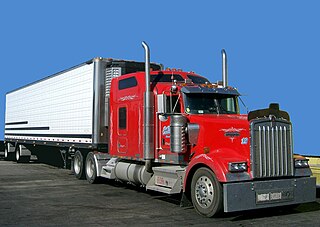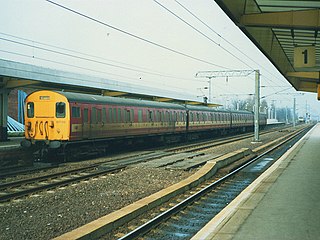Vehicle emissions control is the study of reducing the emissions produced by motor vehicles, especially internal combustion engines.
Vehicle size classes are series of ratings assigned to different segments of automotive vehicles for the purposes of vehicle emissions control and fuel economy calculation. Various methods are used to classify vehicles; in North America, passenger vehicles are classified by total interior capacity while trucks are classified by gross vehicle weight rating (GVWR). Vehicle segments in the European Union use linear measurements to describe size. Asian vehicle classifications are a combination of dimensions and engine displacement.

In all forms of aviation, ground crew are personnel that service aircraft while on the ground, during routine turn-around; as opposed to aircrew, who operate all aspects of an aircraft whilst in flight. The term ground crew is used by both civilian commercial airlines and in military aviation.

A commercial driver's license (CDL) is a driver's license required to operate large, heavy, or placarded hazardous material vehicles in commerce, including trucks, buses, and trailers.
Class 300 was allocated to a proposed fleet of parcels-carrying electric multiple units, which were to be converted from former Class 307 units.

A Propelling Control Vehicle (PCV) is a type of British railway carriage for carrying mail. They were converted from Class 307 driving trailers and have a cab at one end which allows slow-speed movement control. PCVs are unpowered but the controls allow mail trains to be reversed at low speed, using the power of the locomotive at the other end of the train. Similar BR Class 91 Driving Van Trailer (DVT) used on the ECML differ by being fully equipped for high-speed train control.

The British Rail Class 307 electric multiple units were built by BR at Eastleigh Works from 1954 to 1956. They were initially classified as AM7 before the introduction of TOPS.

A crankcase ventilation system removes unwanted gases from the crankcase of an internal combustion engine. The system usually consists of a tube, a one-way valve and a vacuum source.

A bus driver, bus operator, or bus captain is a person who drives buses for a living.

Pneumococcal conjugate vaccine is a pneumococcal vaccine and a conjugate vaccine used to protect infants, young children, and adults against disease caused by the bacterium Streptococcus pneumoniae (pneumococcus). It contains purified capsular polysaccharide of pneumococcal serotypes conjugated to a carrier protein to improve antibody response compared to the pneumococcal polysaccharide vaccine. The World Health Organization (WHO) recommends the use of the conjugate vaccine in routine immunizations given to children.

Pneumococcal vaccines are vaccines against the bacterium Streptococcus pneumoniae. Their use can prevent some cases of pneumonia, meningitis, and sepsis. There are two types of pneumococcal vaccines: conjugate vaccines and polysaccharide vaccines. They are given by injection either into a muscle or just under the skin.

The U.S. state of Pennsylvania first required its residents to register their motor vehicles in 1903. Registrants provided their own license plates for display until 1906, when the state began to issue plates.

The U.S. state of Tennessee first required its residents to register their motor vehicles in 1905. Registrants provided their own license plates for display until 1915, when the state began to issue plates.

The U.S. state of Wisconsin first required its residents to register their motor vehicles and display license plates in 1905. Plates are currently issued by the Wisconsin Department of Transportation (WisDOT) through its Division of Motor Vehicles. Front and rear plates are required for most classes of vehicles, while only rear plates are required for motorcycles and trailers.

In common with cars and trucks, preservation of buses in the United Kingdom is a hobby activity enjoyed by many people, both actively or passively. The active preservation and operation of preserved buses is undertaken by private individuals, organised trusts or societies, and even commercial operators. The preserved bus fleet in the UK includes dating from the earliest pre-war models right up to models manufactured after the year 2000.
The Driver Certificate of Professional Competence is a qualification for professional bus, coach and lorry drivers. It has been introduced across Europe with the aim of improving road safety and maintaining high standards of driving.
The Veterans Bridge is a fixed span concrete bridge that spans the Southern Branch of the Elizabeth River in the Deep Creek neighborhood of Chesapeake in southeastern Virginia, USA. The bridge, which partially opened in 2014, currently carries two lanes of U.S. Route 17 on each direction across its northbound and southbound spans. The corridor frequently acts as a bypass route for congested I-64 High Rise Bridge traffic. It replaces the much shorter and smaller Dominion Boulevard Steel Bridge, which because of its 11-foot underwater clearance opened on average of 16 times per day.
Manulectric was a British marque of milk floats and other battery electric road vehicles. The vehicles were made by Sidney Holes Electric Vehicles, of Brighton, Sussex. They were designed out of Holes' experience of doorstep milk delivery, through Holes and Davigdor Dairies. Both pedestrian controlled vehicles (PCVs) and ride-on models were produced, and entered the market around 1947. The company was bought by Stanley Engineering in the 1960s, and sold to Crompton Electricars in 1972. Some Manulectric models were subsequently manufactured by Harbilt Electric Trucks.
Sony Vaio PCV Series is the first line of products of desktop computers introduced by Sony under their VAIO brand in 1996. The series would be introduced to the Japanese market the following year, with the introduction of the mini-tower computer, PCV-T700MR on July 15, 1997.
This page is based on this
Wikipedia article Text is available under the
CC BY-SA 4.0 license; additional terms may apply.
Images, videos and audio are available under their respective licenses.











